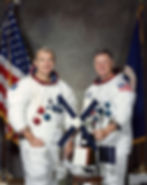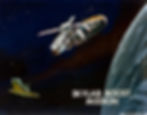NASA's Forgotten Skylab Plans
- Aeryn Avilla
- Jan 8, 2021
- 6 min read
Updated: Aug 10
If you'd rather watch a video than read this post, click here to be redirected to my YouTube channel!
Skylab was the United States' first crewed space station and orbited the Earth from 1973 to 1979. From 1973 to 1974, it was visited by three crews of three astronauts for increasing durations (Skylab 2 for 28 days, Skylab 3 for 59 days, and Skylab 4 for 84 days). Major operations of the space station included an orbital workshop, Earth and solar observation, and life science experiments. Though the single Skylab remained in orbit during the program's duration, its sister station Skylab B was constructed and housed back on Earth.

Skylab B
McDonnell Douglas constructed two space stations for the Apollo Applications Program, which later became Skylab. There were multiple ideas for how to use Skylab B, each more advanced than one in space. In May 1972, President Richard Nixon and Soviet Premier Alexei Kosygin signed the Space Cooperation Agreement, from which the Apollo-Soyuz Test Project was conceived. McDonnell Douglas proposed creating a large space station by combining Skylab with the Soviet space station Salyut. The large station would have been able to accommodate both the Apollo and the Soyuz crewed spacecraft and would have been the first evolutionary step in the eventual International Space Station program.

In mid-1976, McDonnell proposed a 140-day Skylab-Salyut mission to be carried out by multiple concurrent crews of three American astronauts and three Soviet cosmonauts. Skylab and Salyut orbited at different altitudes with different orbital inclinations, but the large space station would have met in the middle and operated at an altitude of 270 miles (435 km) with an inclination of 51.6 degrees. Skylab and Salyut also used different gases and atmospheric pressures for life support so either an airlock or a shared, unique atmosphere would be needed. Using an airlock would also require the crew to rebreathe, or purge nitrogen from the body by breathing pure oxygen, before entering the other country's module. After Apollo-Soyuz brought about the end of the Space Race in July 1975, NASA focused more intensely on developing the Space Shuttle, which was due to enter service in 1979, while the Soviet space program pioneered long-duration spaceflight with Salyut.

Skylab Rescue
Skylab Rescue was a standby rescue mission part of a contingency plan for the space station. Its unique feature was a modified Apollo command module that could be launched with a crew of two and returned with a crew of five. Plans for equipping a command/service module as a space rescue vehicle dates back to late 1965 when technicians at North American Rockwell, the manufacturers of the Apollo spacecraft, conceived the possibility of a rescue mission for astronauts trapped in lunar orbit. Following the release of the 1969 film Marooned, in which a three-man crew and their Apollo craft is stranded in Earth orbit following their stay on a space station, the company revised their original plan, and it was approved by NASA's Marshall Space Flight Center in 1972 [1].


The closest Skylab Rescue ever came to fruition was during Skylab 3 in 1973. Soon after launch, the CSM developed problems with its reaction control system thrusters, called quads. Each service module has four quads. Two quads were shutdown due to leaking once the crew had safely arrived to Skylab. However, if the service propulsion system fuel was contaminated, the spacecraft might not be able to de-orbit and return to Earth. With that risk in mind, NASA considered bringing the crew home immediately, but they were safe on Skylab and rescue flight plans existed. The mission continued.
Meanwhile, the Saturn IB rocket AS-208 and the CSM-119 spacecraft were mated and rolled out to Launch Complex-39B for launch. The crew for this rescue mission was Vance Brand and Don Lind, the backup commander and pilot for Skylab's 3 and 4. They used simulators to test undocking from Skylab and reentering Earth's atmosphere using only two quads instead of the usual four. It was Lind's responsibility to choose what would be brought back with the crew from the station, the most important of which was the film from the Apollo Telescope Mount, a solar observatory.
Cutting corners, the mission wouldn't be ready to launch until September 10, more than a month after the second quad malfunctioned. NASA canceled the rescue mission after it determined the failed quads would not cripple the CSM and the fuel was not contaminated. Brand and Lind backed the conclusion that reentry with the failed quads was safe. In fact, Brand is said to have joked the two of them were "very efficient but perfectly stupid, because we have literally worked ourselves out of the mission" (Shayler, 2001). Skylab 3 returned home as scheduled after completing its 59-day mission.

Brand and Lind continued to work on their backup roles for Skylab 4 as well as train for a possible rescue mission. Spacecraft CSM-119 was mated with AS-209 but was never rolled out to the pad for launch. There were also plans for a 20-day Skylab 5 flight with Brand, Lind, and backup science pilot William Lenoir, but when Skylab 4 was extended from 59 to 84 days, the mission was no longer needed. Brand flew on Apollo-Soyuz the following year and commanded three Shuttle missions from 1982 to 1990— STS-5 Columbia, STS-41B Challenger, and STS-35 Columbia. Lenoir's only flight was Brand's first commanding, STS-5. Lind did not fly until STS-51B Challenger in 1985.

Skylab Reboost
By the late 1970s, Skylab was abandoned and losing altitude. Since the station had no way to reboost itself, NASA ordered the construction of the Teleoperator Retrieval System (TRS), an unmanned robotic space tug developed for satellite boosting and de-orbiting, in October 1977. The TRS would have been launched by the Space Shuttle to dock with Skylab and either boost it into a higher orbit and extend its service life or de-orbit it into the ocean. The mission would have been crewed by Fred Haise, veteran of the Apollo 13 lunar mission and the Space Shuttle Enterprise Approach and Landing Tests, and Jack Lousma, veteran of Skylab 3.
While NASA had plenty of money to develop the TRS, it did not have plenty of time. NASA anticipated the Space Shuttle to complete its maiden flight in 1979 and Skylab to reenter in the early 1980s. However, with delays with STS-1, the first Shuttle mission, the vehicle would not make its first trip to space until April 1981. By 1979, Skylab's orbit was decaying too rapidly to wait at least two years for a re-boost. NASA canceled the development of the TRS and Haise and Lousma's deployment mission, though Martin Marietta, the manufacturers of the Titan rocket family, offered to fly the TRS on a Titan III rocket.

On July 11, 1979, Skylab de-orbited and reentered over the Indian Ocean and Australia. After Skylab and Apollo-Soyuz ended, remaining hardware was donated to museums across the country. This hardware included two complete Saturn V rockets, three Saturn IB rockets, Skylab B, three CSM's, and two Lunar Modules (not including Lunar Module Test Articles). AS-209, the last remaining flight-configured Saturn IB rocket, is on display in the Kennedy Space Center Visitor Complex's Rocket Garden, lying on its side. CSM-119 is at KSC's Apollo/Saturn V Center, but the unique five-seat rescue configuration has been removed.

Author's Note: Thanks for reading and be sure to like, comment, and share!
[1] The movie was adapted from a 1964 science fiction novel by Martin Caidin.
Bibliography
Evans, Ben. “Launch Minus Nine Days: The Space Rescue That Never Was.” AmericaSpace, 12 Aug. 2012, www.americaspace.com/2012/08/12/launch-minus-nine-days-the-space-rescue-that-never-was/
Mars, Kelli. "50 Years Ago: Second Skylab Crew Begins Record-Breaking Mission." NASA, July 2023. https://www.nasa.gov/history/50-years-ago-second-skylab-crew-begins-record-breaking-mission/
Portree, David S. F. “Skylab-Salyut Space Laboratory (1972)." Wired, March 2012. https://www.wired.com/2012/03/skylab-salyut-space-laboratory-1972/
Shayler, David J. Skylab: America's Space Station. Praxis Publishing, 2001.
Uri, John. "45 Years Ago: Skylab Reenters Earth's Atmosphere." NASA, July 2024. https://www.nasa.gov/history/45-years-ago-skylab-reenters-earths-atmosphere/


